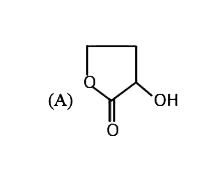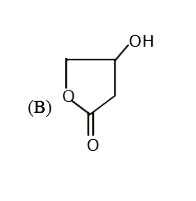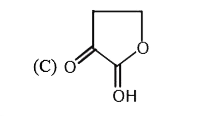HO-CH2−CH2-CH =O (1)KCN−−−−−−−→(2)H⊕(3)H2O⊕(4)Δ(A), Product (A) is ,




The correct Answer is:A
To solve the given question, we need to analyze the reaction step by step. The starting material is HO-CH₂-CH₂-CH=O, which is an aldehyde with a hydroxyl group. The reaction involves KCN (potassium cyanide) and H₂O (water) in the presence of H⁺ ions.
1. Identify the Starting Material:
The starting compound is HO-CH₂-CH₂-CH=O. This is a 3-hydroxypropionaldehyde.
2. Nucleophilic Attack by KCN:
The cyanide ion (CN⁻) from KCN acts as a nucleophile and attacks the carbonyl carbon of the aldehyde (C=O) group. This results in the formation of a tetrahedral intermediate.
Hint: Remember that nucleophiles attack electrophilic centers, such as carbonyl carbons.
3. Protonation of the Intermediate:
In the presence of H⁺ ions, one of the hydroxyl groups can be protonated, leading to the formation of an oxonium ion. This intermediate can then undergo hydrolysis.
Hint: Protonation increases the electrophilicity of the carbonyl carbon, making it more reactive.
4. Hydrolysis:
Water (H₂O) attacks the carbonyl carbon of the oxonium ion, leading to the formation of a new hydroxyl group and the conversion of the carbonyl to a hydroxyl.
Hint: Hydrolysis is a reaction where water is used to break bonds, often resulting in the formation of hydroxyl groups.
5. Formation of a 5-Membered Ring:
The lone pair on the oxygen can attack the carbonyl carbon, forming a 5-membered cyclic intermediate. This step is crucial as it stabilizes the structure.
Hint: Cyclic structures often form in reactions involving nucleophiles and electrophiles due to the stability of ring formations.
6. Deprotonation:
The nitrogen in the intermediate can accept a proton, leading to the formation of an amine group. This step is essential for the final product.
Hint: Deprotonation is a common step in organic reactions that helps stabilize charged intermediates.
7. Formation of the Final Product:
The leaving group (NH₃) departs, and we are left with a double bond between carbon and oxygen (C=O) along with a hydroxyl group (OH) on the adjacent carbon.
Hint: The leaving group is often a good nucleophile or a stable molecule that can depart without destabilizing the product.
8. Final Structure:
The final product A is a compound with a carbonyl group (C=O) and a hydroxyl group (OH) adjacent to it, which corresponds to the structure of a 5-membered ring compound.
Conclusion:
The product A formed from the reaction is a 5-membered cyclic compound with a hydroxyl group and a carbonyl group.
Final Product:
The final product A is 5-hydroxy-2-oxopentanenitrile.
The starting compound is HO-CH₂-CH₂-CH=O. This is a 3-hydroxypropionaldehyde.
The cyanide ion (CN⁻) from KCN acts as a nucleophile and attacks the carbonyl carbon of the aldehyde (C=O) group. This results in the formation of a tetrahedral intermediate.
In the presence of H⁺ ions, one of the hydroxyl groups can be protonated, leading to the formation of an oxonium ion. This intermediate can then undergo hydrolysis.
Water (H₂O) attacks the carbonyl carbon of the oxonium ion, leading to the formation of a new hydroxyl group and the conversion of the carbonyl to a hydroxyl.
The lone pair on the oxygen can attack the carbonyl carbon, forming a 5-membered cyclic intermediate. This step is crucial as it stabilizes the structure.
The nitrogen in the intermediate can accept a proton, leading to the formation of an amine group. This step is essential for the final product.
The leaving group (NH₃) departs, and we are left with a double bond between carbon and oxygen (C=O) along with a hydroxyl group (OH) on the adjacent carbon.
The final product A is a compound with a carbonyl group (C=O) and a hydroxyl group (OH) adjacent to it, which corresponds to the structure of a 5-membered ring compound.
The product A formed from the reaction is a 5-membered cyclic compound with a hydroxyl group and a carbonyl group.
The final product A is 5-hydroxy-2-oxopentanenitrile.
Topper's Solved these Questions
- BOOK - MOTIONCHAPTER - CARBONL COMPOUNDSEXERCISE - EXERCISE -2 (LEVEL-II)18videos
CARBONL COMPOUNDS
- BOOK - MOTIONCHAPTER - CARBONL COMPOUNDSEXERCISE - EXERCISE - 310videos
CARBONL COMPOUNDS
- BOOK - MOTIONCHAPTER - CARBONL COMPOUNDSEXERCISE - EXERCISE -140videos
CARBONL COMPOUNDS
- BOOK - MOTIONCHAPTER - BIOMOLECULES & POLYMERSEXERCISE - EXERCISE - 4 (LEVEL II)17videos
BIOMOLECULES & POLYMERS
- BOOK - MOTIONCHAPTER - CARBOXYLIC ACIDEXERCISE - Exercise - 4 (LEVEL - 2 )22videos
CARBOXYLIC ACID
Similar Questions
Knowledge Check
- Question 1 - Select One
CH3−CH2−O−C∣CH3=CH2H3O⊕−−−→Products are
A B
B C
C D
D
- Question 2 - Select One
Ch3−CH2−C≡CHR−−−→H3O⊕ Butanone, R is
AHg+2BKMnO4CKClO3DK2Cr2O7 - Question 3 - Select One
H3C−CH2−C∣∣O−CH3NaBH4−−−−→D2O Product ?
AH3C−OD∣C∣H−CH2−CH3BH3C−OHC∣∣D−CH2−CH3CH3C−OD∣C∣D−CH2−CH3Dnone
CH2−CONH2|CH2−CONH2P2O5−−→Δ(P)H2O⊕−−−→Δ(Q)
The product (Q) isView SolutionIn the given reaction
CH3−CH2−C∣∣NaOH−CH3H2SO4−−−−−−−−−−→(H2O/H+),Δ(A)+(B)
A and B are:View SolutionPh−CH2−O∣∣C−OH(1)NaOH,CaO,Δ−−−−−−−−−−−−−→(2)H⊕(A)
Product (A) is:View SolutionCH3−C∣BrH−CH2−O∣∣C−CH3N2H4,ӨOH−−−−−→Δ product :
View SolutionCH3−(CH2)3−OHCH3−O∣∣S∣∣O−Cl−−−−−−−−−→ET3N(A)14KCN−−−−−→(B)H3O⊕−−−→(C)
Product (C) is :View Solution

